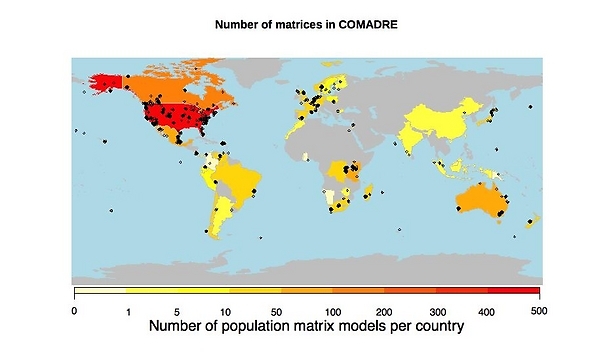January 27, 2016 | News | New Database
COMADRE: Uniform data for Biodemography
Recently, the Open Access database COMADRE went online. The database run by the MPIDR contains demographic information on an unprecedented variety and number of animal species. In an article published today in the Journal of Animal Ecology, the makers of the database present their project.
The database fills a gap in the current availability of Open Access data: "There are collections about animal migration, about the distribution of species, genes, or for species conservation. A database that collects such detailed demographic information on animal species has been missing so far," says MPIDR guest researcher Roberto Salguero-Gómez (also a Research Fellow of the Australian Research Council at the University of Queensland, Australia), who initiated the project together with Owen Jones (Max Planck Center Odense on the Biodemography of Aging at the University of Southern Denmark) while at the MPIDR. The database is financed and supported by the MPIDR and is an addition to the existing database COMPADRE, that contains demographic information on hundreds of plant species.
The data are deposited in the database in form of so-called matrix population models. (See the book by Hal Caswell). In these matrices demographic data are not necessarily organized by age only - as in human mortality tables - but also by biologically meaningful size ranges or stages that play a role in the life course of an animal. Biodemographers use this division into stages because most of the time they are unable to determine the exact age of wild animals. A biologically meaningful stage is, for example, the body size of an animal, its developmental status (young, or sexually mature adult animals), or its reproductive status (breeding, non-breeding). This classification is useful, because demographic rates such as mortality or the reproductive rate are often determined by the particular life stage of the animal rather than simply by age.
Each of the matrix models in the database describes the dynamics of a particular animal population as a combination of three processes: reproduction, survival, and the transitions of individuals within a population over their lifecycle. Using the matrices, these data are standardized in a way that enables comparison among animal species that could hardly differ more. This way, for example, the demographic data of the nematode Caenorhabditis elegans, the smallest multicellular organism in the world, are comparable to data from the African elephant or humans. "Before, it was not possible to make these comparisons. Only by comparing mortality and fertility schedules among organisms can we learn more about the evolution of species," says Alexander Scheuerlein, the MPIDR-representative of the database.
"We can use this information, for example, to gain a better understanding of the environmental conditions that have led to the huge diversity of demographic strategies in the animal kingdom, or to detect early warning signals of species extinction," concludes co-founder Owen Jones.

Geographic representation of animal demographic studies in COMADRE 1.0.0. The points represent study sites for which GPS coordinates are available. Countries with redder colour contain more matrix models.
The creation of the database required complicated and non-trivial diligent work: There are a lot of MPM data in the literature with new data being published every week. It takes a lot of time to sort the wheat from the chaff, to bring the data into the same format and merge them into a database. “This work would not have been possible without the many highly-motivated student helpers we have,” says Alexander Scheuerlein. The version of the database just released online contains data on 345 animal species from 402 different scientific sources and a total of 1625 matrices. To be able to interpret the models better, COMADRE also contains information specific to a particular study or matrix, such as spatial data and reference to the original data set. In addition, “we have worked diligently to complement this information with additional ecological, biogeography and taxonomic information that will give its users a broader ecological and phylogenetic context,” states Roberto Salguero-Gómez.
The database is anything but a static entity. "The goal is that other researchers will contribute their data, so that our big data pool will continue to grow and be used by scientists around the world," says Owen Jones. “This capability which we are currently working on, will be made available soon to our users at www.comadre-db.org.”
More Information
www.comadre-db.org - Website of the database
COMADRE: a global data base of animal demography - Article in Journal of Animal Ecology)